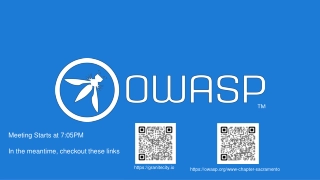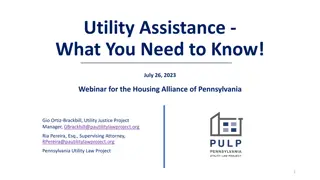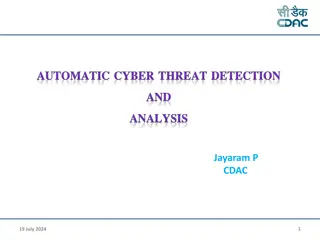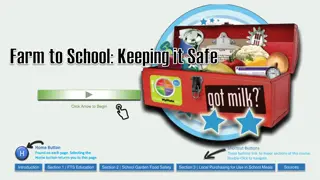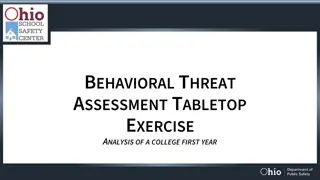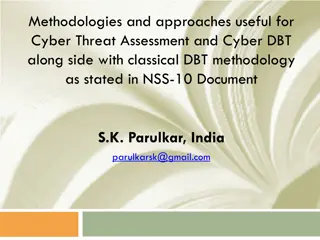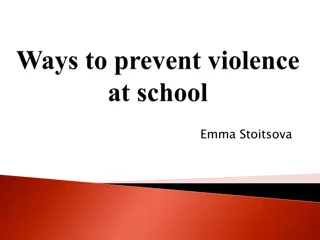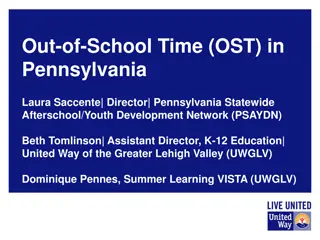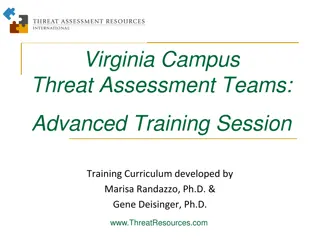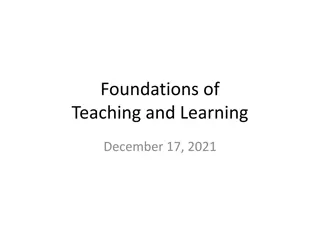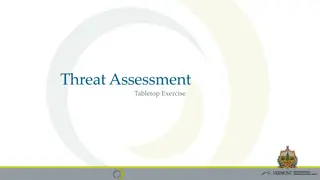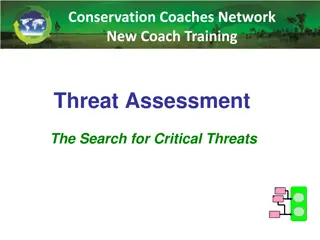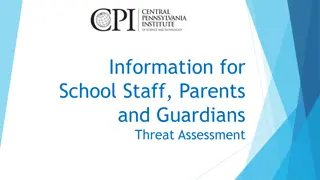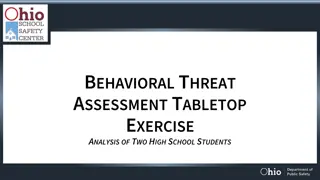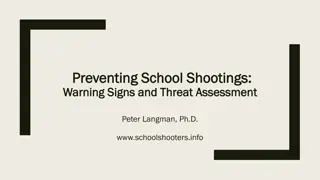Pennsylvania School Threat Assessment: Keeping Schools Safe
Pennsylvania schools have implemented a Threat Assessment Team to ensure the safety and security of students, staff, and community members. The team follows specific guidelines and procedures to assess and address threats, involving key stakeholders and promoting collaboration among multidisciplinary teams. The statute mandates training, communication, and compliance with laws to maintain a safe school environment. This presentation provides information for school staff, parents, and guardians on threat assessment processes and responsibilities.
Download Presentation

Please find below an Image/Link to download the presentation.
The content on the website is provided AS IS for your information and personal use only. It may not be sold, licensed, or shared on other websites without obtaining consent from the author. Download presentation by click this link. If you encounter any issues during the download, it is possible that the publisher has removed the file from their server.
E N D
Presentation Transcript
Information for School Staff, Parents and Guardians Threat Assessment
Introduction Pennsylvanians are concerned about the safety and security of the students, staff, and community members who enter school buildings on a daily basis. How do we keep our schools safe?
Introduction In June of 2019, legislation was enacted to assist schools in creating safer environments. One of the acts, Article XIII-E, Threat Assessment was added to the Pennsylvania School Code. The law states that each school entity (school district, intermediate unit, area career and technical school, charter school, regional charter school, or cyber charter school) shall establish at least one threat assessment team. In accordance with the legislation, the School Safety and Security Committee (SSSC), Pennsylvania Commission on Crime and Delinquency (PCCD), and key stakeholders from across Pennsylvania developed model procedures and guidance materials to help local schools establish and operate threat assessment teams.
Information Guide The information in this presentation is to provide school staff, parents and guardians with: Overview of the Pennsylvania Statute Definition of Threat Levels of Threat Definition of Threat Assessment An Overview of The Threat Assessment Team Members Key Responsibilities Of The Threat Assessment Team Procedures and Guidelines Guidance Documentation
Information Guide The Role of the Team Once a Threat Has Been Made School Staff and Mandated Reporting Strategies that Schools Have in Place to Help Students Recognizing At-risk Behavior Where To Report Observable Behaviors Summary Resources
Overview of Statute: What Do Schools Need To Do? In accordance with 24 P.S. 1302-E - 1303-E, schools shall provide the following: 1. Establish a Threat Assessment Team 2. Facilitate opportunities for team members to be trained on best practices in the threat assessment process 3. Informational Materials a) Students (age appropriate) b) Parents/Guardians c) School Employees
Overview of Statute: What Do Schools Need To Do? 4. Annually present to the school board a report outlining the school s approach to threat assessment. 5. Ensuring Compliance with Federal and State Laws/Regulations Regarding Student Record Confidentiality 6. Communication and Coordination with Other Multidisciplinary Teams a) Student Assistance Program (SAP) Teams b) Special Education Teams (IEPs, 504 Plans, etc.)
Definition of Threat Threat is a communication or behavior that indicates an individual poses a danger to the safety of school staff or students through acts of violence or other behavior that would cause harm to self or others. The threat may be expressed/communicated behaviorally, orally, visually, in writing, electronically, or through any other means. These actions can be considered a threat regardless of whether it is observed by or communicated directly to the target of the threat or observed by a third party, and regardless of whether the target of the threat is aware of the threat. Virginia Department of Criminal Justice Services
Levels of Threat One in which the individual/situation does not appear to pose a threat of violence or serious harm. Low One in which the person/situation does not appear to pose a threat of violence, or serious harm at this time; but exhibits behaviors that indicate a continuing intent and potential for future violence or serious harm. Moderate One in which the person/situation appears to pose a threat of violence, exhibiting behaviors that indicate both a continuing intent to harm and efforts to acquire the capacity to carry out the plan; and may also exhibit other concerning behavior that requires intervention. High Exists when the person/situation appears to pose a clear and immediate threat of serious violence toward others and requires containment and action to protect identified or identifiable target(s); and may exhibit other concerning behavior, requiring intervention. Imminent Virginia Department of Criminal Justice Services
Defining Threat Assessment Threat assessment is a fact-based process for the assessment of and intervention with students whose behaviors may indicate a threat to the safety of the student, other students, school employees, school facilities, the community, or others. PA Public School Code, Article XIII-E. Threat Assessment. Threat assessment is a prevention strategy. School communities work together to identify student threats before they become acts of violence Schools have systems in place to process information Students receive assistance through early identification
The Threat Assessment Team The people on the threat assessment team are appointed by the superintendent or executive director in consultation with the school safety and security coordinator. There are some positions that are required in statute to be on the team and there are others that may be assigned based on the needs of the school. The chief school administrator is to appoint a threat assessment team leader. In addition, when a student is referred to the threat assessment team, it would behoove the team to consult with or engage the participation of someone in the school building who knows the student well, whether that be a teacher, aide, custodian, secretary, food service worker, coach, or other school staff person.
The Threat Assessment Team The Threat Assessment Team should include: Required Members Individuals with expertise in: Optional Members Other school staff or community resources who can assist with threat assessment process Examples: School security personnel; law enforcement agencies; behavioral health professionals; individuals receiving reports from Safe2Say Something Program; SAP team members; juvenile probation professionals; etc. School health Counseling, school psychology, or social work Special education School administration School safety and security coordinator
Threat Assessment Team: Key Responsibilities Provide materials for students, school employees and parents/guardians. Assess and respond to reports of threat from varying resources; make appropriate determinations, referrals, and notifications. Provide information necessary for annual reporting.
Threat Assessment Team Guidance Each school entity is responsible for developing procedures and guidelines that meet the needs of their school community. The SSSC, PCCD and other key stakeholders have developed model procedures and guidelines to assist schools, which can be found on the PCCD website at https://www.pccd.pa.gov/schoolsafety/Documents/Threat%20Assessment%20 Model%20Procedures%20and%20Guidelines,%20Final%20-%2012-17-2019.pdf . Additionally, guidance on the following components is available on the PCCD website at https://www.pccd.pa.gov/schoolsafety/Documents/Guidance%20Communicati ons%20and%20Information%20on%20Confidentiality,%20Final%20-%2012-17- 2019.pdf : Coordination between the threat assessment team and other school-based teams; Confidentiality, privacy and consent; Considerations for students with disabilities; and Considerations for SAP teams
What Will the Team Do, Once a Report Is Made? 1. Once the team receives a report of a potential threat, it is their job to assess and intervene with the student and determine the level of threat. 2. If the student s behavior indicates a threat to the safety of the student, other students, school employees, school facilities, the community or others, the team will immediately notify: a) The chief school administrator or a designee b) The building principal c) The school safety and security coordinator
What Will the Team Do, Once a Report Is Made? 3. The building principal or designee shall then immediately notify the student s parent or guardian, respond and make appropriate determinations and referrals based on the information available to the team. 4. Following notification of the parent/guardian, the team may refer the students, as appropriate to: a) The Student Assistance Program b) A law enforcement agency c) An evaluation under the Individuals with Disabilities Education Act (IDEA)
What Will the Team Do, Once a Report Is Made? d) A student's existing individualized education program (IEP) team established under IDEA and 22 Pa. Code Ch. 14 (relating to special education services and programs) e) An existing team established to implement a student's section 504 service agreement established under section 504 of the Rehabilitation Act of 1973 and 22 Pa. Code Ch. 15 (relating to protected handicapped students) 4. A parent or guardian shall provide consent prior to a team referring a student to: a) A behavioral service provider b) A health care provider c) A county agency
School Staff and Mandated Reporting School employees shall act immediately to address an imminent threat. Imminent threats and emergencies shall be promptly reported to a law enforcement agency. School employees and other mandated reporters shall follow the responsibilities regarding reporting suspected child abuse as required by law. For more information on child abuse recognition and mandated reporting go to: Department of Education: ACT 126 Child Abuse Recognition and Reporting Act; and Department of Human Services: Keep Kids Safe
School Staff and Mandated Reporting Nothing shall limit the authority of a school entity to refer a student to the student assistance program without referral by a team, so long as the student's behavior does not indicate a threat to the safety of the student, other students, school employees, school facilities, the community or others. The goal of this process is to ensure the safety of the school community, and also to ensure that the student presenting the threat receives assistance through a range of strategies already established in the school.
Strategies That Schools Have in Place Some of the strategies/supports that schools have in place when a report is made are: Student Assistance Team (SAP) Mental Health Services PBIS/MTSS Teams IEP Team Support Groups Mentoring Addressing Inappropriate Behavior Setting Reasonable Boundaries Suspension Law Enforcement Other, based on school need
Recognizing At-Risk Behaviors There are observable behaviors which may not be normal and are out-of-character for most students. These behaviors may lead to acts of violence. If the behaviors are noticed early on and dealt with through the strategies that are in place in the school, then appropriate measures can be taken to assist the student before the violence occurs.
Recognizing At-Risk Behaviors Some observable, at-risk behaviors include: Unusual social distancing or isolation of individuals from peers and family members Sullen or depressed behavior from an otherwise friendly and positive person Out of context outbursts of verbal or physical aggression Increased levels of agitation, frustration and anger Confrontational, accusatory or blaming behavior An unusual interest in weapons Fixation on violence as means of addressing a grievance K-12 Threat Assessment in Virginia: A Prevention Overview for School Staff, Parents, and Community Members
Key Findings According to a study done by the U.S. Secret Service and the U.S. Department of Education, incidents of targeted violence at schools are rarely sudden, impulsive acts. They are well-planned. The following are key findings of the study that provide insight and awareness for school personnel to prevent violence. There is no profile of a student attacker, nor is there a profile for the type of school that has been targeted. Attackers usually had multiple motives, the most common involving a grievance with classmates. Most attackers used firearms, and firearms were most often acquired from the home. Most attackers had experienced psychological, behavioral, or developmental symptoms. Protecting America s Schools: A U.S. Secret Service Analysis of Targeted School Violence, National Threat Assessment Center U.S. Secret Service, U.S, Department of Homeland Security, November 2019
Key Findings Half of the attackers had interests in violent topics. All attackers experienced social stressors involving their relationships with peers and/or romantic partners. Nearly every attacker experienced negative home life factors. Most attackers were victims of bullying, which was often observed by others. Most attackers had a history of school disciplinary actions, and many had prior contact with law enforcement. All attackers exhibited concerning behaviors. Most elicited concern from others, and most communicated their intent to attack. Protecting America s Schools: A U.S. Secret Service Analysis of Targeted School Violence, National Threat Assessment Center U.S. Secret Service, U.S, Department of Homeland Security, November 2019
Reporting If a student is exhibiting out-of-character behaviors, one should seek to get help and report the instances in a timely manner, following school protocol for reporting procedures. Schools have methods that they use to report threats and other at-risk behaviors. Your school s procedure will have the most updated listing and steps to follow. Contact your school administrator for more information on the school s procedures and threat assessment team.
Reporting In January of 2019, Pennsylvania initiated the Safe2Say Something Anonymous Reporting System, which is run through the Attorney General s Office. It is a 24/7 hotline that allows people to submit tips via phone calls, a secure website or a mobile app. The reporting system allows people to submit secure and anonymous safety concerns to help identify and intervene upon at-risk individuals BEFORE they hurt themselves or others. Individuals can do this by reporting observed threats, behaviors, actions and harassment. Find out more information on the Safe2Say Something website. A downloadable APP for mobile devices is available on Google Play and the App Store.
Reporting Safe2Say Something Call the Safe2Say Something hotline at 1-844-SAF2SAY to report: Assault Abuse (physical, verbal) Bullying or regular intimidation Bragging about an upcoming planned attack Depression, anxiety or loss of self-control Fighting Gun Violence / Violence Harassment Hopelessness, excessive guilt or worthlessness Reckless behavior Social isolation or withdrawal Substance abuse Suicide threats, cutting or other self-harm Theft Threats Weapons (use of and/or discussion about)
Summary Pennsylvania statute requires that school entities, as defined in 24 P.S. 1301-1303-E, are to establish threat assessment teams, procedures, and reporting protocols. Schools can adapt the Pennsylvania Model Procedures and Guidelines to meet their needs in preventing school violence. The threat assessment process is a prevention strategy used to identify and assess threats of violence before the act occurs. Students usually plan out the attack in advance, exhibiting observable behaviors and making others aware of their plans.
Summary It may be possible to prevent future school attacks from occurring through awareness education, following reporting procedures and using the threat assessment team to help students who may have the intent and capacity to commit an act of violence. Not only are schools a place to learn, they are also a place of safety and security for the students, staff and community members who walk through the doors. The school community s awareness and participation in the threat assessment process will help to ensure the safety of the people and buildings.
Resources There are many resources that can help you to learn more about the threat assessment process and what you can do to assist. Talking with students about violence The National Association of School Psychologists (NASP) is an excellent resource for information in assisting schools and families in dealing with acts of violence, threats of violence, and the threat assessment process in schools. NASP has information that can assist adults in speaking with students. Talking to Children About Violence: Tips for Parents and Teachers provides printable documents of developmentally appropriate tips, with infographics in both English and Spanish: Talking to Children Hablarles a los ni os
Resources Suicide Awareness The Pennsylvania Department of Human Services provides support in suicide prevention efforts. The Office of Mental Health and Substance Abuse Services works with youth-based organizations and schools to develop youth suicide prevention activities. Prevent Suicide PA provides education, resources, and trainings so that people are more aware of the warning signs of suicide and how to prevent it from occurring.
Resources State Policies, Procedures and Guidance Documentation: Pennsylvania s Model K-12 Threat Assessment Procedures and Guidelines provides more information on the threat assessment team process; Act 18 of 2019 Guidance for School Entities: Communications and coordination for the threat assessment team with other school-based teams; and Compliance with Federal and State student record confidentiality laws and regulations.
Resources Your School s Procedures Schools should add links to where their policies are posted Local Organizations Schools should add links to county/local resources and community organizations
Resources Working with other support teams in schools: Positive Behavior Interventions and Support (PBIS) - PBIS is a proactive, multi-tiered approach to discipline that promotes appropriate student behavior and increased learning. Student Assistance Program - The Pennsylvania Student Assistance Program (SAP) is a systematic team process used to mobilize school resources to remove barriers to learning. The primary goal of the Student Assistance Program is to help students overcome these barriers so that they may achieve, advance, and remain in school. Multi-Tiered Systems of Support - Pennsylvania s Multi-Tiered System of Support (MTSS) is a standards-aligned, comprehensive school improvement framework for enhancing academic, behavioral and social-emotional outcomes for all students.
Resources Individualized Education Program (IEP) - An IEP is the written plan for the education of a student who has a disability or is gifted. The IEP is based on the individual student's needs and describes the special help that the student will receive in school. To write an effective IEP for a child with a disability, parents, teachers, other school staff and often the child come together at a meeting to look closely at the child s unique needs. A student who is gifted has a Gifted Individualized Education Plan (GIEP). The GIEP includes all curricular areas in which the student is to receive education that is adapted and modified to meet their individual needs.
Resources 504 Service Agreement - A student that does not qualify for special education services under IDEA (an educational law) still may qualify for services under Section 504 (a civil rights law) if the disability is shown to substantially limit his or her educational performance. A child with a disability is one who has a physical or mental impairment that substantially limits major life activities, such as caring for one's self, performing manual tasks, walking, seeing, hearing, speaking, breathing, learning and working. Accommodations often refer to building accessibility, classroom adjustments and curriculum modifications and may be updated or revised as the need changes.
Resources Laws regarding confidentiality, privacy and consent: Several laws address privacy of student information, including: The Family Educational Rights and Privacy Act (FERPA), which restricts disclosure of information from student education records The Individuals with Disabilities Education Act (IDEA), which protects certain special education information of students with disabilities State laws in Pennsylvania and adopted board-level policies also provide privacy protections for students. Go to Pennsylvania s Threat Assessment Guidance to find out more about the laws protecting student and family privacy.


